Deni
- Self-denomination
- Jamamadi
- Where they are How many
- AM 2064 (Siasi/Sesai, 2020)
- Linguistic family
- Arawá
The Deni are among the indigenous groups of the region of the Juruá and Purus rivers who, in the 1940s, suffered the impacts of the second rubber boom, which attracted thousands of migrants. With these, there came sicknesses, violent territorial disputes and exploitation of indigenous labor. Since then, the Deni had to wait decades until they got their territorial rights guaranteed, and even then only after a campaign for the demarcation of their lands, supported by several NGOs, which succeeded in getting official demarcation, but which was only completed in August, 2003. Even then, they confronted the problems resulting from recurrent invasions for clandestine activities such as fishing and timber extraction.
Name and language
The Deni of the Xeruã River call themselves "Jamamadi-Deni", while the Deni of the Cuniuá River call themselves "Madihá-Deni". This differentiation is the result of the influence of the New Tribes Mission of Brazil, which has worked in the region of the Cuniuá River since 1982.
The Deni language belongs to the Arawá language family. Few studies exist about the Arawá language, which, besides the Deni language, includes the following languages: Paumari, Jamamadi, Banawa–Yafi, Jarawara, Kulina and Suruwahá, all of these ethnic groups being inhabitants of the ethnographic area of the Juruá-Purus (Melatti, 1998). According to the linguist Aryon Rodrigues, the languages of the Arawá family are very similar amongst themselves, although the Paumari language is a little different from the others (Rodrigues, 1986:71). Dixon calls the language spoken by the Jarawara, Jamamadi and Banawa-Yafi, “Madi” for he states that they are mutually intelligible and share 95% of the vocabulary. According to the author, Madi has a strong grammatical and lexical similarity with the Deni and Kulina languages (Dixon, 1999: 292-306).
Location and population
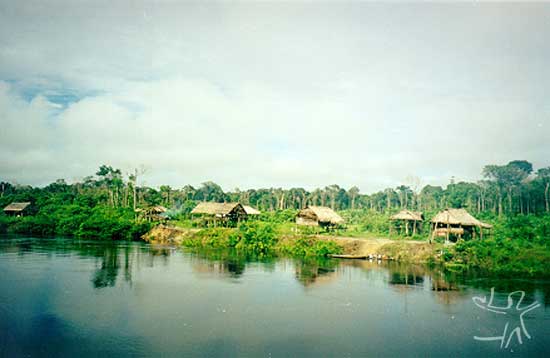
The Deni Indians inhabit an extensive region between the Juruá and Purus rivers, in the municipalities of Itamarati, Lábrea and Tapauá, in the State of Amazonas. According to the environmental report prepared by Pezzuti, the indigenous area is part of the hydrographic basin of the Solimões and is drained by a tributary of the Juruá, the Xeruã River, and by the Canaçã and Cuniuá, tributaries of the Tapauá, which in turn flows into the Purus. The Deni Indigenous Land is located in the region that separates the drainage basin of these two great rivers of white water (the Juruá and the Purus).
For the purposes of analysis, the indigenous land can be divided into two parts: the Western and the Eastern. In the western portion, there are four villages, located on the Xeruã River and on several of its tributaries. They are: Rezemã, Morada Nova, Boiador and Itaúba. The Xeruã is a tributary of the Juruá River. In the eastern part there are four more villages, all located on the banks of the Cuniuá River, tributary of the Purus River: Cidadezinha, Marrecão, Visagem and Samaúma.
There is no fluvial connection between the Xeruã and the Cuniuá; by land there is a road (a large path through the forest) that connects the village of Itaúba to the old village of Kumarú Novo. The trip takes on the average three days. The trip to the other villages could take up to one or two weeks. There are various roads that interconnect villages and places for hunting, gathering and fishing.
In May, 1999, we recorded that 666 Indians inhabited the indigenous land in 116 houses distributed in nine villages. Data recorded in 2002 by the NGOs Greenpeace, CIMI and OPAN indicated an increase in population to 736 people, in eight villages. In 2010 the Deni population reached 1.254, according to data by FUNASA,
History and territorial situation
The first interventions by the State that sought to regularize the land situation of the Deni Indigenous Land and other indigenous lands of the Juruá-Purus ethnographic area date from the 1930s. The Indian Protection Service agent, José Santana Barros, participated in an inspection trip to the Tapauá River and its tributaries between March 16th and April 24th, 1930. He presented a travel report, in which he mentions and discusses the diverse ethnic groups who inhabited the region. It was a first attempt at identifying areas inhabited by the Indians on the Juruá-Purus, which was followed up by other expeditions of the SPI in the 1940s. Unfortunately, no proposal for regularizing the land situation was presented, despite the reports which presented very interesting data.
Many years later, a work group was created through decree n.º 1813/E, of January 7th, 1985 to proceed with the studies of identification and surveys of occupation seeking to define the borders of the Deni Indigenous Area. Five technicians were named, who were supposed to complete fieldwork within 30 days. The anthropological report, which was the responsibility of the researcher Therezinha de Barcellos Baumann, was never presented. The work group only produced the descriptive memorial for delimitation [an official document providing the exact coordinates of the area to be delimited] and two pages of information on the number of non-Indian occupants and approximate Deni population. The Deni Indigenous Area was defined with a total surface area of 998,400 hectares and a perimeter of 750 kilometers.
On January 21st, 1992, the Special Analysis Commission created by the Funai for the purpose of using the studies done prior to decree n.º 22/91 and making them adequate to the new demands, authorized the indigenists of the Indigenist Missionary Council (CIMI) Gunter Kroemer and Terezinha Weber to verify the possibility of approving the borders defined in 1985. The approval procedure occurred on June 5th, 1992, in the village of Kumarú, at which time the Indians demonstrated their disapproval of the proposal, for the delimited area did not include all of the lands traditionally occupied by them.
In 1995, Kroemer presented a report seeking to provide additional information for the definition of the borders of the indigenous land. However, as in the meeting with the indigenous community in 1992 it became clear that the Deni did not agree with the result of the 1985 studies, which made new studies of identification and delimitation necessary.
In the same year of 1995, a health team of the Funai went to the Xeruã River to vaccinate and provide health treatment to the Indians, who were still recovering from the devastating outbreak of measles which occurred in 1992. The anthropologist Eduardo Vieira Barnes went with the team, for he was hired to render consultant services to undertake ethnological studies for the purpose of identifying and delimiting the Deni Indigenous Land. However, after his return to Brasília, the anthropologist requested rescission of the contract. Another Work Group was designated, coordinated by Rodrigo Padua Rodrigues Chaves (author of this entry). The fieldwork was done in two stages: from November 23rd, 1998 to January 5th, 1999 and from April 10th, 1999, to May 28th 1999, totalling 93 days. According to the report of the Work Group, approved by the Funai in February, 2001, the Deni Indigenous Land was identified with a surface area of 1,530,000 hectares. In December of the same year, the Ministry of Justice declared the area to be the permanent possession of the Indians and, in May 2003, it was demarcated.
Indigenous demarcation and official demarcation
[Edited by the staff of the ISA on the basis of news reports]
The process of demarcating Deni lands was preceded by a movement organized by the Deni with support from the NGOs Greenpeace, Cimi and Opan. In 1999, Greenpeace investigated the purchase of 313 thousand hectares of forest by the Malaysian lumber giant, WTK, which would exploit lumber in the region in order to make thin sheets of wood for export. Greenpeace discovered that more than 150 thousand hectares acquired by the WTK overlapped the Deni area.
In light of the slowness in the official process of demarcation, the Indians decided not to wait for the Funai any longer and began the process of demarcation of their territory by themselves. In 2001, a multidisciplinary team worked with the Deni leaders of all the villages, and the Indians learned how to use instruments such as compasses, surveying instruments and GPS. At the same time, the Greenpeace waged a campaign with clients of the WTK and the company ended up declaring that it would not exploit the area overlapping the Deni land and that it would not appeal to Justice against the process of demarcation.
In September, 2001, the Deni began the process of demarcating their own territory with the help of 13 volunteers and a helicopter provided by Greenpeace. After more than a month, the Ministry of Justice ordered the demarcation process to be interrupted and the NGOs to leave the area. But the Deni refused to stop. After much negotiation, in October, 2001, the then Minister of Justice signed the Demarcation Decree and, in May, 2003, official demarcation finally began.
On August 5th, the Deni celebrated the conclusion of the demarcation of their land with songs and dances, after 18 years of waiting. With the demarcation of the Deni land, an ethno-environmental ‘corridor' of more than 3.6 million hectares of Amazonian forest will be formed, connecting eight indigenous lands.
Cosmology and society
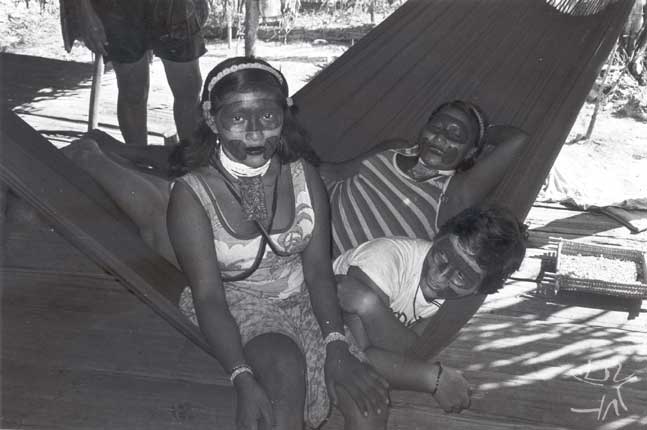
According to research by Koop (1983), preferential marriage takes place between cross-cousins, that is, the girl marries her father's sister's son; the young man marries his mother's brother's daughter. Marriage between parallel cousins is considered incestuous, such that the father's brothers are classified as father (abi), and the mother's sisters are in the same category as mother (ami).
The residence rule after marriage tends to be matrilocal: "when the young man marries, he goes to live in the house of the woman", Hamú said, the patarahú (chief) of the old village of Buzina, thus expressing the ideal of matrilocality. The missionary Gordon Koop states the following: “As soon as the girl approaches the age of puberty, the father generally arranges her marriage and his daughter's husband then goes to live in the same house, or in a house to the side of his wife's father. For three lunar months, the daughter's husband receives nothing from his wife, outside of amorous favors. On the other hand, he must hunt, fish, gather forest fruits, and give everything over to his wife's mother (mashudini), except for a small portion that he gives to his own mother. After this period of three months, his wife begins to cook for him, bringing food to him in a plate, as his wife's mother did before. Then, he goes on to divide what he hunts or fishes between his wife and his wife's mother, setting aside a small part for his mother.
Generally, the son-in-law lives near his father-in-law for a period of a year or more, during which he works with him in most of his projects, such as the building of houses or cutting of the forest... also, he hunts and fishes together with his wife's father. The son-in-law can move far away, as long as he gets his father-in-law's consent” (KOOP, 1983:18).
Despite the system of matrilocality, descent on the father's side constitutes the basis of social organization. Men who have the same father (but different mothers) or whose parents have a common father (cousins) comprise a kindred that generally live close together, share the same collective labor and arrange the marriages of their daughters and sons. If a group of brothers has three or more adult men with women and children, they can move away from the woman's father's house and build their houses nearby. Thus, the structural links of the extended family are those between a group of brothers or between the wife's father (hedi) and his daughters' husbands (hirubadi).
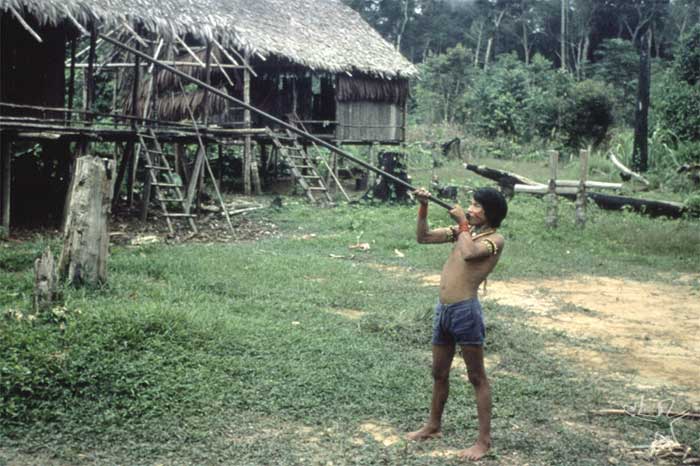
With the population survey of the eight Deni villages, the existence of the following subgroups was determined:
- Seruvá Kudé Deni. People of the Xeruã, as the Deni of the Cuniuá call them;
- Upanavá Deni. They came from the other side of the Purus River, crossed over the Purus, then the Pauni River, went up the Mamorea and Aruá rivers , until they got to the Cuniuá river. They are a majority in the village of Marrecão – Beira Rio;
- Bukuré Deni. They came from the Aruá River, tributary of the Cuniuá. They are a majority in the villages of Visagem and Samaúma;
- Kunivá Deni. They came from the lower Cuniuá River, and are a majority in the village of Boiador;
- Varasá Deni. They came from the Xeruã River, and are a majority in the village of Cidadezinha;
- Minú Deni. They came from the Curabi stream, tributary of the Xeruã River. They are a majority in the village of Morada Nova;
- Katú Deni;
- Havá Deni, people of the patauá palmtree. They are a majority in the village of Rezemã and in the Deni Indigenous Land;
- Tamakuri Deni. They are a majority in the village of Marrecão-Pista de Pouso;
- Mei Vessé Deni. People of the white taro;
- Makui Deni, who are a majority in the village of Itaúba;
- Zumahé Deni, people of the jaguar, of whom there only exists one member in the indigenous land;
- Putavi Deni. This group also has only one member.
Political organization
Traditionally, the members of the village who have a prominent political position are the chiefs (patarahú) and the shamans (zupinehé). In the past, one or another had several wives. There is no literal tradition for patarahú, but the closest would be “chief of the domestic group". In the last few years, due to the influence of the Funai and the missionaries who work in the region, the role of the patarahú has come to have greater importance and is today the synonym for tuxaua, that is, chief of the village. The elderly men of the village, for their part, are generally the Imabuté, story-tellers.
According to Koop, the principal criteria for choosing the chief of a village are that he be a mature man (with sons of an age to run), preferentially whose father was chief and, above all, who has a spirit of leadership and personal characteristics that qualify him for the post.
The chief, however, cannot make decisions arbitrarily, but has to discuss them beforehand with the adult men of the village (that is, men with sons of an age to run and that participate in the ritual of rapé, shina). In meetings that take place shortly before dawn, plans are presented and debated. From his hammock, the chief or anyone who wishes to, begins to speak in a loud voice. Comments echo over the central plaza coming from men lying in their respective hammocks. Thus, decisions and projects for the day are collectively made (Koop, 1983).
Mobility and dwelling-space
The history of the occupation of the indigenous land by the Deni indicates that the average occupation time of a village generally does not exceed five years. Several factors determine the abandoning of a village. Besides the very dynamics of the formation and subdivision of domestic groups, one of the factors is the sicknesses brought by the “White men” and which have resulted in high rates of mortality, sicknesses such as tuberculosis, measles and pneumonia, among others. Epidemics result in the abandonment of the villages and the dispersal of the survivors.
Sahavi, patarahú of the Morada Nova village, recalls the first contacts with the Whites: “in the past, there were no Whites, only Indians. Then the White man came in here...he had measles, chickenpox, flu. But in the past, we didn't know, whoever got phlegm [i.e., respiratory disease] died, who didn't have medicine died, died, died. Then the others ran away, scattering, to where there is no sickness. When he got sickness he died, in the past, he would go and stay far away to not get flu. They died, they killed, they died, and died, and died, and died. He would go upriver again, higher up, the Whites also go after him. For that reason the Deni have few people, because of sickness. Now the Deni people are growing again.”
Another factor has to do with the availability of resources for the subsistence of the village population, for the Deni are outstanding hunters and the hunt is a highly values activity among them. After several years living in the same place, game becomes scarce, leading the hunters to spend more and more time and energy to get ever less meat. This influences their choice to move to a place with greater availability of resources. There are exceptions, such as the village of Marrecão, which has been in existence for more than ten years. This is due to the presence of missionaries of the New Tribes Mission of Brazil (MNTB), which has a landing strip at the village. However, there is a high degree of dissatisfaction among the Indians, for there is almost no more game or fish in a wide radius around the village.
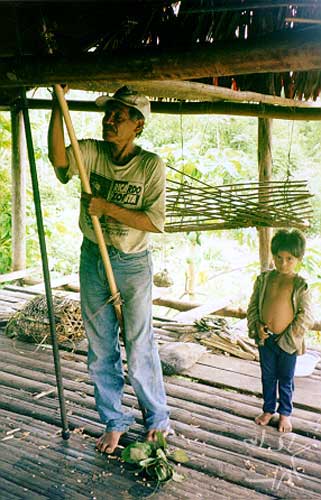
The Deni houses, in general, don't have walls, and are built at a height that varies between 1.5 and 3 meters from the ground in order to avoid the presence of animals. The posts and base of the house are made of resistant wood, such as jatobá, matá-matá, acapú, acariquara, among others. The floorboards are made of paxiúba trunks and the roof is made of caranaí thatch, which is woven over strips of paxiúba trunk. The Deni houses last on the average three years. The kitchen is generally located attached to the main construction or next to it.
Sickness and death
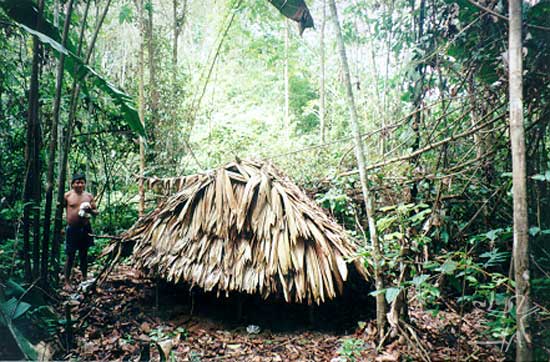
The Deni suffered an intense population decline, mainly after 1940, with the intensification of contact with extractivist fronts, which led to the disorganization and later re-organization of various Deni subgroups. Various outbreaks of tuberculosis, pneumonia, and measles have been identified during the history of contact with the surrounding society. The physical and cultural reproduction of the Deni was threatened and, in the beginning of the 1990s, this indigenous society reached its maximum in depopulation. In 1992, specifically, there was an outbreak of measles which resulted in the death of 67 Indians in the period of 12 months. The mortality rate in that period was 12%. Various denunciations were made at that time, as well as quite simple emergency measures, such as vaccination against measles, were taken. A slow process of recovery of the group began over the last decade. Nevertheless, the Deni still face serious problems in the area of health, and only get occasional support from non-governmental organizations (NGOs) and government agencies, such as the Funasa.
Due to the very high level of Deni mortality, cemeteries are very numerous and are distributed throughout the indigenous land. The form of burial follows the same pattern in all the villages: the deceased is wrapped in a hammock and placed in the grave, which is about two meters deep. The hammock is tied inside the grave, which is not covered with earth. On top of the grave they put strips of paxiúba trunk and over the paxiúba they put earth. Finally, a small house in the Deni style is built over the grave.
According to Sahavi Deni, when the patarahú (chief of the domestic group) dies, his body is kept near his residence and all occupants wail for four days. They make a fire underneath his hammock so that it doesn't rot. All villages come to weep for the dead. They bury him near the house and garden.
Shamanism and rituals
Presently, shamanism is increasingly rarer among the Deni. Traditionally, the shamans (zupinehé) were prepared to exercise this function since three years of age. According to what Koop (1983) surveyed, the fundamental difference between the shamans and the other men is the presence of a substance called Katuhe in their bodies, and the ability to communicate personally with the spirits (tukurime). Katuhe is a yellow and thick wax extracted from honeycombs in the forest. The shaman chews this substance before having visions and communicates with the spirits. He can experience nausea, but after approximately two weeks of chewing, vomiting and sleeping in his hammock, he declares that he has flown to the sky, where he hears the tukurime.
The main attribute of the shaman of the village is to have visions and to serve as intermediary with the spirit world, in such a way that he can identify the causes of sicknesses and deaths, as well as guide the population in preventing against these misfortunes.
Again according to Koop, when a Deni dies, the shaman seeks to converse with his spirit to determine the cause of death. To do that, he chews katuhe until he has a vision in which he grows wings, flies to the sky and sees the spirits of Indians (abanu) and dangerous spirits. He then discovers what happened to the spirit of the dead person or who was responsible for the aggression. Based on this information, the people decide whether they should move to another place or do something to avoid future aggressions.
Besides treating sick people, traditionally the shaman even has some political responsibilities. Just like the chief of the village, he can invite everyone for a festival. In all the festivals, the shaman was the singer par excelence. After a night of celebrating a festival, the men got together on the plaza of the village arm-in-arm, with the shaman near the center. After the women form a line facing the men, the shaman begins each song and the others would follow him singing, dancing, first to the front, then to the back around the circle (Koop, 1983). These days the function of singer can be performed by other people. In any case, in all the festivals, the singer – hiridé – performs a fundamental role. All the Deni sing and many have their own songs, some of which are quite popular.
In 1999, I had the opportunity to observe a curing ritual in the village of Marrecão. Sivirivi, of Cidadezinha village, had allergy to wild pig meat (anubezá) and, every time that he would consume this meat, he would get digestive problems. On April 25th, 1999, Sivirivi was not well at all and asked me to take him to the village of Marrecão to ask the zupinehé to ‘pray'[i.e., perform a cure], for, according to him, this was the only way he would get better. We got to Marrecão and went to the house of Zutihári, who put the sick person lying down on a plank of wood. The zupinehé then went on to remove the sickness sucking the places affected (stomach and intestine) and then spitting out the sickness. At the same time, he would massage the affected region. The work of curing lasted eight minutes, at the end of which two stones were removed from Sivirivi belly. A short while later, the sick person said that he felt relieved and finally the symptoms of illness disappeared.
Festivals and games
The festivals occur with frequency throughout the year, principally the ima amusinahá, literally translated as “prolonging the good conversation”. But it is during the Amazonian summer that the Deni spend a large part of their time preparing and participating in these festivals. In that time of plenty, celebrations take place that last several days. For example, Sahavi talked at length about the Summer festival (banivá danará), which lasts up to 30 days. The Deni spend three months hunting every day, in preparation for the festival.
In the past, this type of ritual was more frequent. In it, the chief of the village told stories all day long and his house was always full of people.
There are various types of games, among them one in which the participants follow a trail in the forest which is especially prepared for the occasion. Each village has its representatives, who have to run with an arrow, passing it on to his fellow runners, with the objective of seeing who runs more and arrives first in the host village. On arriving in the village, everyone eats game animals and bananas and drinks caiçuma.
Another game is the sugarcane, in which men and women compete with one another; this can take place at any time of the year. The men go to fetch sugarcane in the garden and, on arriving in the village, they leave the cane on the ground. The community joins together on the spot and the men begin circulating with pieces of sugarcane, which have to be taken by the women. The first time, the men let them take the pieces without offering any resistance. After that, the women have to take the sugarcane away from them forcibly, beginning a veritable battlefield, where everything goes. The game ends when all the pieces of sugarcane have been taken by the women. In the same way, when it is the women who go to get sugarcane in the garden, it is the men who have to take the cane from them.
Koop witnessed a similar ritual when he was among the Deni (1983), but on that occasion the men brought manioc for the women to eat. The author commented that the women booed, laughed, and left their houses to eat small portions, the whole time commenting on the men for everyone to hear. After that, the chief brought a large aluminum tray, a large pot of manioc and a bowl of meat or fish to the center of the plaza. After turning the manioc over on the tray, he calls the people to participate in the festival. One by one, each domestic group brought manioc and meat or fish. Men and boys then formed a circle; women and girls formed another. Each person had his own bowl or plate with a portion of manioc and meat. Among those of the same sex, adult men and women passed meat and fish from one plate to another, meaning that often, one piece of meat would pass among many people before being eaten.
Commonly this meal would begin at nightfall and would go on until late in the night. Then the dance continued and could go on until dawn. On the following morning, men and women could wrestle on the plaza. The women often would wrestle amongst themselves for fruits or pieces of sugarcane. At times, however, they would challenge the men. The event ended with everyone dirty and tired, but generally happy (Koop, 1983).
Contact with non-Indians
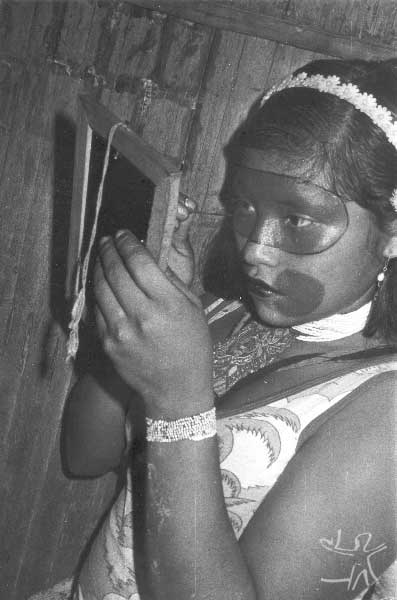
The reports of the Deni indicate that their intensive contact with the cariú (Whites) dates from the 1940s. At the beginning of contact, in the 1940s and ‘50s, the Indians sold animal skins, such as jaguar (which they traded for new shotguns and munitions), otter, maracajá [wildcat], caitetu, wild boar, tapir, bushmaster and snake. In the 1950s, several Indians were already engaged in the extraction of latex. In the 1960s and ‘70s, they went on to extract sorva and timber and, since the 1980s, the Deni have worked in extracting copaiba oil and fine quality timber.
Intense contact and subsequent depopulation were the result of the second rubber boom, in the 1940s, due to the demand which arose during the Second World War. In this context, the region of the Juruá-Purus was literally invaded by thousands of Brazilians. Even in the 1980s (1985), there were several families of non-Indian occupants on the Xeruã (31) and the Cuniuá (22) rivers. Of these, in 1999, only seven remained on the Xeruã and one family on the Cuniuá.
From the beginning, the economic relations between the Deni and the Whites were marked by exploitation, with the system of selling merchandise on credit having been reproduced up to the present day. In this system, the merchant (boss) sells merchandise to be paid later in exchange for extracted products. Today, the figure of the rubber boss has disappeared and has been replaced by the river merchant or regatão. A merchant who uses the boat as his means of transport, living quarters, and mobile store, the regatão does business with the populations who live on the rivers and streams of the Amazonian forest, and is often the only economic tie these people have with the national market.
On the Cuniuá River, several times the Deni blamed the regatão for the lack of food in several villages, for he exchanged products such as salt and sugar for manioc flour, paying an insignificant price for the flour, and charging exorbitant amounts up to 400% higher than the real value of the product, creating a debt that the Indians would never be able to pay. On the Xeruã River, it is possible for the Indians to sell several products in the city of Itamarati, which is two days trip from the village of Itaúba.
Various Deni were working outside the indigenous land in the extraction of copaíba, timber and other jobs. Others have gone to Manicoré, on the Madeira River. A small group is living in Manaus.
Environmental crimes are quite common on the Deni Indigenous Land. This is in large part due to the total lack of fiscalization and assistance from the Funai. Much less is the Ibama capable of controlling such practices. Every year, in the months from October to December, scores of fishing boats (regionally known as peixeiros) concentrate at the junction of the Xeruã and the Juruá rivers. Most come from Cruzeiro do Sul (AC), Eirunepé, Manaus and Carauari (AM). On the Cuniuá River, the problem is similar – scores of fishing boats go up the river with the objective of fishing matrinxã. The fishing of species threatened with extinction is another problem that the Deni are not able to control. The most sought after species are the manatee, the pirarucu and the turtles. The Indians are beginning to become more organized to prevent such crimes.
Another crime that is quite common is the illegal extraction of timber on indigenous land. The most highly valued species are the: andiroba, cedar, jacareúba, copaíba, laurel, saboeiro, samaúma, among others. Rosewood was intensely exploited in the 1980s and ‘90s, which practically led to its extinction in the region. In the region of the Xeruã River, exploitation is principally done by lumbermen from Itamarati and Carauari. On the Cuniuá and Tapauá rivers, the exploiters are from Foz do Tapauá; these, however, are mere middlemen for the lumbermen of Manaus, where all of the illegal lumber is transported.
Productive Activities
The Deni find most of the food they need for their subsistence in the forest. Mobility is a fundamental condition for their survival.
Hunting
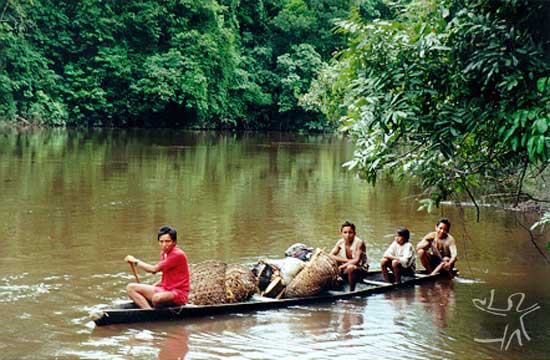
Hunting is of great importance in the Deni productive system. It is a typically male activity that is highly valued by the group. The hunts are done in basically two ways: following the trails in the forest, seeking to track the animals or signs of them. Bands of wild pigs, which can number up to 300 animals, leave conspicuous trails in the forest where they pass and are called Rizama Raviné. Caitetus, tapirs and deer also leave their tracks, which can be followed for a whole day. In this type of hunting, dogs are of fundamental importance, for they track and corner the game animal; and the other way is by hunting in the mud pits, which are specific flooded places that are constantly visited by a great variety of animals, which leave the soil totally exposed and, for the most part, nude. Most times, the mud pits are located at the headwaters of the streams.
The Deni raise various forest animals, such as the big-bellied monkey, the guariba and prego monkeys, jacamim, jacu and jabuti [turtle]. Besides the forest animals, they also raise domestic animals: dogs, ducks, chickens and pigs.
Fishing

Like hunting, fishing has a place of central importance in obtaining products which comprise the Deni diet. Fishing is an important source of protein, above all during the Amazonian summer, when the fish become more abundant.
Fishing is a diversified activity and involves the use of various techniques: bow and arrow, fish poison vekamá, hook and line. The long fishing expeditions, which require several days of travel and the building of camps, are done only by the men and older youths. Fishing with poison involves the whole community, from the gathering of Vekamá leaves to the preparation of the poison and the fishing expedition, and the preparation of the fish.
Fishing also varies in relation to the type of environment in which it is practiced. All of the watery environments of the indigenous land are used for fishing. According to the biologist Juarez Pezzuti, "lakes (Kurizá), small-bays, canals, the main channels of the rivers and the flooded forest or igapó, are all exploited to obtain fish and turtles. Seasonal variation in the level of the river decisively influences the distribution of the aquatic fauna and, consequently, the places where fishing takes place in every period of the year. When the river is at its lowest, the fish are concentrated in the remaining bodies of water, which facilitates fishing. To the extent the water rises, the fish invade newly available habitats in the flooded forests in search of food, and the fishermen watch this movement thus selecting new places to fish. This dispersion increases the difficulty of catching fish, both on indigenous land and in the Amazonian basin in general. The time of the full river is the period of scarcity. (...)
The technique of fishing with hooks was learnt from the Whites. Possibly the greater part of the animal protein consumed by the Deni is obtained through fishing with hooks baited with worms (Sumi), the use of which was also learnt from the Whites. Besides hooks baited with fish and worms, we observed the use of several fruit as bait, such as the Araçá” (PEZZUTI, 1999).
The fish poison vekamá is also used to fish piau, in a quite ingenious fashion. The Indians mix the poison with the larvae of a species of wasp and a bit of manioc flour. They make a little ball with the mixture and use it as bait. The fish eat the bait and soon appear, asphyxiated, bobbing on the surface, and are then easily speared.
The Deni of the village of Cidadezinha travel over great distances to fish and gather turtle eggs. The fish along the whole Cuniuá River up to the São Luís stream and the Canaçã River. They gather turtle eggs on the Cuniuá and Canaçã rivers during the Amazonian Summer and fish tortoise and tracajá in trips that last up to eight days, on the Canaçã River. They catch the turtles when they surface to breathe, using arrows with iron tips. As fishing is only for consumption, they catch at the most five turtles per person.
Agriculture
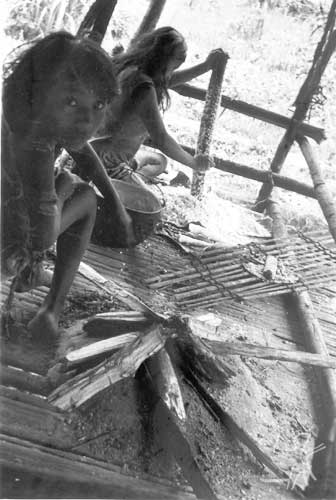
The importance of agricultural products for the Deni is explained by the fact that the main food source of plant origin and of carbohydrates comes from gardens. Several gardens, divided into family plots, have up to 15 hectares and, each year, new gardens are planted. The garden areas of the old villages continue to be exploited for up to 15 years, both for gathering fruits and for hunting, for they are locations where animals tend to gather.
It is a common practice for new gardens to be prepared in the place of old gardens, in the garden plots adjacent to the villages, diminishing the necessity of making new gardens ever more distant from the houses. After four years, gardens are beaten down again, reburnt and replanted, in several cases more than once. This re-cycling occurs when the village is located in an area where higher lands are scarce, and also when there exists a greater demand for a new garden for planting manioc and sweet cassava. The work of cutting the brush and making the garden is obviously easier if it is done in primary forest, but on the other hand, it is probable that the yield in these secondary and tertiary gardens is less, due to the exhaustion of the soil which is poor in nutrients.
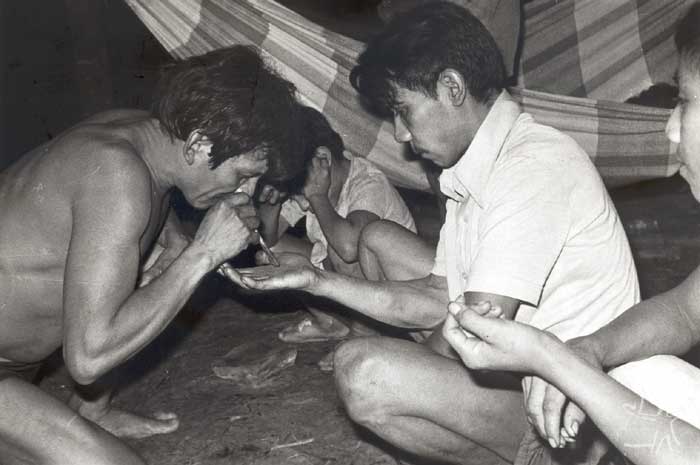
The following is a list of the plants produced in the Deni gardens: manioc, sweet cassava, various types of yams, taioba, peppers, bananas (of several varieties called tumumu, biriharu, putaharu, vesevi, napinipana, katumi, arazu, bisasa and kasia ba), ananás, sugarcane, cotton, tobacco, tingui (fish poison, vekama), urucum, pupunha, sweet potato, caju, papaya, graviola, araticum, biribá, cubiu, cupuaçu, corn, avocado, tobacco (two types)” (Pezzuti, 1999:25-26).
Tobacco is cultivated a lot, but it does not meet the demand of the Indians, for it is at the basis of rapé snuff, a product that is highly appreciated by the Deni. The rapé, according to Pezzuti, is obtained “through the mixture of pulverized tobacco leaves with the ashes of the bark of Pupuí (Theobroma sp.), which contains the stimulant Teobromina (Anderson Guimarães, personal communication). This rapé is widely used by the men and women in various daily activities (...), and also at night, before going to sleep. It can be inhaled directly or by using an inhaler, the Piri, made with the bones of the ulna of the Humu (Ateles sp.) monkey. It can also be placed in the mouth between the teeth and the cheeks, or simply swallowed.” (Pezzuti, 1999:29).
The first stage in making a garden consists of cutting the native forest, which is done on a community basis. In general, the cutting occurs in April and in the month of August, there is the burning of the trees and the burning of the brush. About two weeks after the burning of the brush, planting begins.
Artwork
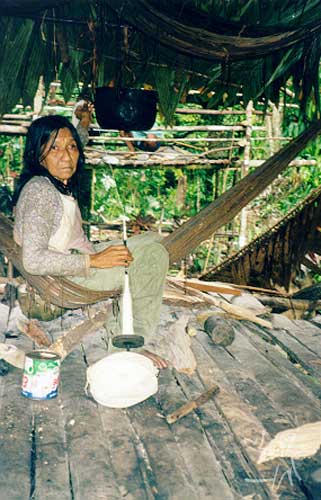
The production of artwork by the Deni does not represent an alternative source of income, in large part because of the difficulty of marketing the production. Nevertheless, the Indians produce various types of artwork for group use: cotton hammocks, baskets, ceramic recipients, collars, bracelets, rings, wooden sculptures, toys, bows, arrows, blowguns etc. There are various ceramic-makers on the Cuniuá River, two of which are generally indicated as the main ones: Taisá, from the village of Marrecão and Amanihú, of the village of Cidadezinha.
Extractivism
O Copaíba oil (karumã) is one of the principal products that the Deni sell. The way in which it is extracted, however, indicates that it is a resource that is becoming less and less marketable, as it is becoming scarcer and more difficult to be obtained. The reason for this is that the Indians extract the oil using the axe, with which they cut a groove into the tree, which ends up killing the tree. The Indians understand that this form of exploitation is predatory and is not the best alternative. They have requested that the Funai provide them with boring tools (in order to bore holes in the stalk of the tree, from which the oil is removed), in such a way that the copaiba stands can be used several times.
There are at least two kinds of tapiris (camps) on the Canaçã River that the Indians of the villages of Cidadezinha, Marrecão and Visagem use when they go to extract copaiba oil. These places are also used during hunting or fishing expeditions. A road connects these places to the village of Cidadezinha, which is travelled over in a day's walk.
Timber extraction occurred frequently on the indigenous land and the Deni were used as manual labor. The "whites" always cheated them when it cam time to pay, which made the Indians become uninterested in this kind of activity. Thus, today, timber extraction occurs without the consent of the Indians and even against their will.
Besides working for non-Indians in timber exploitation inside the Deni Indigenous Land, several Indians were working for lumbermen at the mouth of the Tapauá on the Coatá stream. They leave their families in the indigenous land and spend months outside, later returning without money and without merchandise.
The Deni gather various forest fruits, such as patauá, açaí, bacaba, buriti, pupunha etc. Various gathering expeditions are organized in different times of the year.
The mashed bark of the amapá tree is called batú and is used by mothers to carry their infants. The ash of the inner bark of the caripé tree is used harden the clay used in the making of earthen recipients. The tsubicutsu (caripé) is used to make ceramics, the bark of which is burned and ground. The ash that is produced (Kununé) makes a fastener when mixed with earth.
The Deni also gather honey. However, this activity is not systematic and its frequency depends on the availability of the resource. Honey comes from various species of bees: jandaira (Rizi Tereré), Abi Itsúi, arapuá (Rizi Vaká), uruçu (Rizi Vesevi), Zumahê, pepper bee (Abi Kashi), among others..
Ehtno-pharmacology
The Deni gather various species of vines and other plants: the plant poison karatunahú, used for hunting (with a blowgun or bow and arrow) is prepared from the mixing of two vines, the irrá and the bekú (Curarea tecunarum); inupupu (jurubeba), is used as anesthesia for toothaches; they use the roots of patsi, which are pounded and drunk in the form of tea to relieve toothaches. The mapidzú is a local anaesthetic for stingray bites; they use the leaves of unuvana rebeberi in an emulsion to diminish fever; the vine tsudá kumani is used for the same purpose as unuvana rebeberi, to bring down the fever in children; teterú is a top made with the fruit of the Anthodiscus amazonicus; the Avi kuburi, a mixture of the leaf mashed in water induces vomitting and puts an end to depression; zuká is a vine out of which porridge is made to induce vomiting, and makes the person who drinks it strong and “smart”; burinú is a vine that gives the hunter “marupiara”, luck in hunting. The gathering and preparation of these plants obey strict rules, so that they can produce beneficial results for the person. The zupinehé (shamans) have the greatest knowledge of these plants, which does not prevent, however, any other Deni from knowing how to use them.
Sources of information
- CHAVES, Rodrigo Padua Rodrigues. Relatório circunstanciado de identificação e delimitação da Terra Indígena Deni. Brasília : Funai ; Unesco, 2000. 102 p.
- CIMI. Agonia do povo Deni : dossiê. Brasília : Cimi, 1995. 86 p.
- DIXON, R. M. W. Arawá. : DIOXN, R. M. W.; AIKHENVALD, Alexander Y. (Eds.). The amazonian languages. Cambridge : Cambridge University Press, 1999.
- KOOP, Gordon; LINGENFELTER, Sherwood G. Os Dení do Brasil Ocidental : um estudo de organização sócio-política e desenvolvimento comunitário. Dallas : Museu Internacional de Cultural, 1983.
- --------. The Dení of Western Brazil : a study of sociopolitical organization and community development. Dallas : SIL/Museum of Anthropology, 1980. 92 p. (Museum of Anthropology Publication, 7).
- MELATTI, Julio Cezar. Índios da América do Sul : Áreas etnográficas. v. 2. Brasília : UnB, 19987.
- PEZZUTI, Juarez Carlos Brito. Relatório de levantamento ambiental da Terra Indígena Deni. Manaus : Univers. do Amazonas, 1999. 51 p.
- PRANCE, Ghillian T. The poisons and narcotics of the Dení, Paumari, Jamamadí and Jarawara indians of the Purus river region. Rev. Brasileira de Botânica, s.l. : s.ed., v.1, p. 71-82, 1978.
- RODRIGUES, Aryon dall’Igna. Línguas brasileiras : para o conhecimento das línguas indígenas. São Paulo : Loyola, 1986.